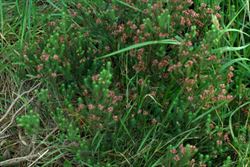Click on images to enlarge

habit (Photo: Forest and Kim Starr, USGS)
Scientific Name
Erica baccans L.
Family
Ericaceae
Common Names
berry flower heath, berry heath, berry-flower heath, berryflower heath, berry-flowered heath
Origin
Native to southern Africa (i.e. Cape Province in South Africa).
Naturalised Distribution
Naturalised in the temperate regions of Australia (i.e. in south-western Western Australia, south-eastern South Australia, southern Victoria and Tasmania).
Notes
This species is regarded as an environmental weed in Victoria, South Australia and Tasmania, and as a potential environmental weed or "sleeper weed" in other parts of southern Australia. It is currently of most concern in Victoria, where it has invaded heathlands, woodlands, grasslands and dry sclerophyll forests.
Berry-flowered heath (Erica baccans) appears on numerous local environmental weed lists (e.g. in the Yarra Ranges, Mornington Peninsula and Cardinia shires) and has also been recorded growing in several conservation areas (e.g. in Grampians National Park, Arthurs Seat State Park and Rosebud Reserve) in this state. It is listed as a major environmental weed in Arthurs Seat State Park and is considered to be a potential threat to the survival of the endangered Frankston Spider-orchid (Caladenia robinsonii) in Rosebud Reserve near Melbourne.
Berry-flowered heath (Erica baccans) is also regarded as an invasive plant of bushland in the Adelaide Hills district in south-eastern South Australia. It is also reported to be invading intact native vegetation in Montacute Conservation Park, to the north-east of Adelaide, in the Southern Mount Lofty Mountains region. In Western Australia, berry-flowered heath (Erica baccans) has become naturalised at Albany and along the Shannon River, where it grows in disturbed sites, on hills, and in jarrah woodlands.

